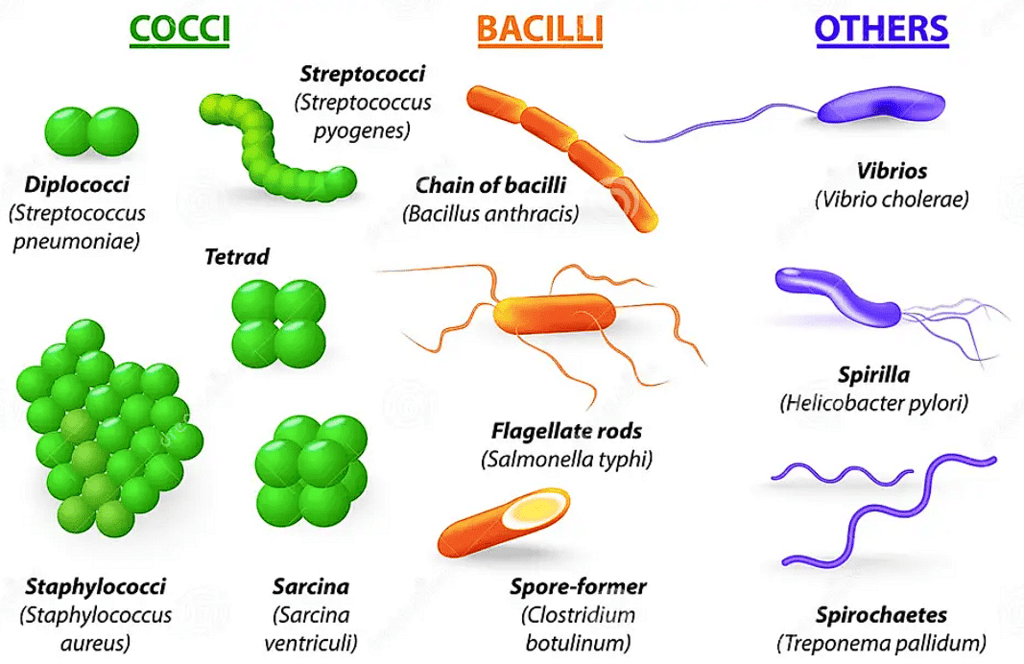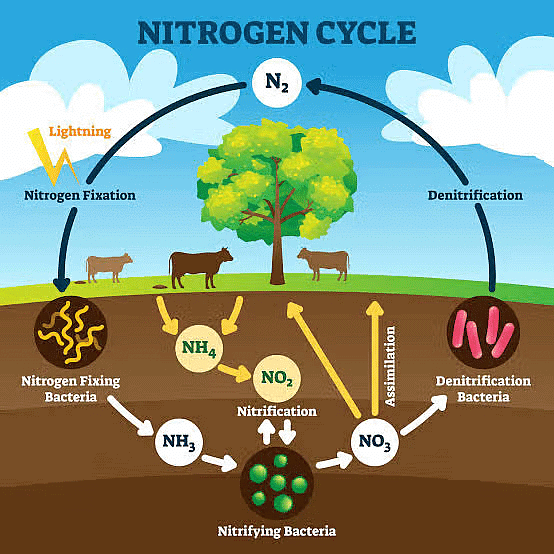Microbes in Human Welfare Class 12 Notes Biology Chapter 8
| Table of contents |

|
| Microbes in Human Welfare |

|
| Role of Bacteria in Nitrogen Cycle |

|
| Useful Activities |

|

|
Microbes in Human Welfare
Bacteria
(1) Study of bacteria is called bacteriology.
(2) Linnaeous placed them under genus vermes.
(3) Nageli classified bacteria under schizomycetes.
(4) Bacteria are unicellular, microscopic organisms.
(5) These are the smallest cell wall having prokaryotic cell.
(6) They differ from animals in having a rigid cell wall and being capable to synthesize vitamins.
Size
(i) Bacteria are the smallest of all known cellular organisms which are visible only with the aid of microscope.
(ii) They are 3 to 5 microns (1 m = 1/1000 millimetre or about 1/25,000 inch) in length.
(iii) A few species of bacteria are approximately 15m in diameter.
Shape
 Various Shapes of Bacteria
Various Shapes of Bacteria
(i) The shape bacteria usually remain constant.
(ii) Some of them are able to change their shape and size with changes in environmental conditions. Such bacteria, which change their shape, are called pleomorphic.
(iii) The bacteria possess the following forms.
(a) Cocci: (GK. Kokkos = Berry) They are oval or spherical in shape. They are called micrococcus when occur singly as in Micrococcus, diplococcus when found in pairs as in Diplococcus pneumoniae, tetracoccus in fours, streptococcus when found in chains as in Streptococcus lactis, staphylococcus when occurring in grape like clusters as in Staphylococcus aureus and sarcine, when found in cubical packets of 8 or 64 as in Sarcina.
(b) Bacilli: They are rod–shaped bacteria with or without flagella. They may occur singly (bacillus), in pairs (diplobacillus) or in chain (streptobacillus).
(c) Vibrios: These are small and ‘comma like, kidney like. They have a flagellum at one end and are motile, vibrio bacteria has curve in its cell e.g., Vibrio cholerae.
(d) Spirillum (Spira = Coil): The spirillum bacteria (plural-spirilla). They are spiral or coiled like a cork-screw. The spirillar forms are usually rigid and bear two or more flagella at one or both the ends e.g. spirillum, spirochaete, etc.
(e) Filament: The body of bacterium is filamentous like a fungal mycelia. The filaments are very small e.g. Beggiota, Thiothrix etc.
(f) Stalked: The body of bacterium posses a stalk e.g. Caulobacter.
(g) Budded: The body of bacterium is swollen at places e.g. Retrodomicrobiom.
Role of Bacteria in Nitrogen Cycle
Nitrogen cycle existing in nature, comprises of:

Nitrogen Fixation
(1) Many free-living soil inhabiting bacteria such as, Azotobacter (aerobic), Clostridium (anaerobic), etc. have ability to fix atmospheric nitrogen into ammonia.
(2) The other group of nitrogen fixing bacteria lives in symbiotic association with other plants.
(3) The most important symbiotic nitrogen fixing bacteria is Rhizobium spp.
(4) The various species of Rhizobium inhabit different leguminous plants. For example, R. leguminosarium infects soyabeans, etc.
(5) They develop root nodules and fix atmospheric nitrogen into ammonia in symbiotic association with leguminous plants.
(6) The fixed nitrogen is partly taken up by the leguminous plants and metabolised.
(7) A part of fixed nitrogen is diffused out into the surrounding soil.
Ammonification
(1) The nitrogenous compounds of the dead remains of plants, animals and their excretory products are decomposed into ammonia by a number of bacteria and other microorganisms.
(2) The conversion of nitrogenous organic compounds into ammonia is termed as ammonification.
(3) It is carried by many ammonifying bacteria such as Bacillus ramosus, B. vulgaris, B. mycoides, etc.
Nitrification
(1) Many bacteria enhance the nitrogen fertility of soil by converting ammonium compounds to nitrites (e.g., Nitrosomonas) and nitrites into nitrates (e.g., Nitrobacter).
(2) The Nitrosomonas group oxidizes ammonia into nitrite –
(3)The Nitrobacter group oxidizes nitrite to nitrates –

Denitrification
The nitrates and ammonia are converted to nitrous oxide and finally to nitrogen gas by several denitrifying bacteria, e.g., Pseudomonas fluorescence, P. denitrificans, Bacillus subtilis, Thiobacillus denitirficans, etc.
Useful Activities
(i) Decay of organic wastes: Many saprotrophic bacteria act as natural scavengers by continuously removing the harmful organic wastes (i.e., dead remains of animals and plants) from man's environment. They decompose the organic matter by purification and decay. The simple compounds produced as a result of decomposition and decay (viz., carbon dioxide, carbon monoxide, nitrates, sulphates, phosphates, ammonia, etc.) are either released back into the environment for recycling or absorbed by the plants as food. Thus, the bacteria play duel role by disposing of the dead bodies and wastes of organisms and by increasing the fertility of soil.
(ii) Role in improving soil fertility: Saprotrophic bacteria present in soil perform various activities for their survival. Some of these activities improve the fertility of soil by formation of humus, manure, etc.
(a) Humus: The microbial decomposition of organic matter and mineralization results in the formation of complex amorphous substance called humus. The humus improves the aeration, water holding capacity, solubility of soil minerals, oxidation-reduction potential and buffering capacity of the soil.
(b) Composting: It is conversion of farm refuse, dung and other organic wastes into manure by the activity of saprotrophic bacteria (e.g., Bacillus stearothermophilus, Clostridium thermocellum, Thermomonospora spp, etc.)
(c) Adding sulphates: A few sulphur bacteria (e.g., Beggiatoa) add sulphur into the soil by converting H2S into sulphates.
(iii) Sewage, disposal: Ability of anaerobic bacteria to purify the organic matter is used in the the sewage disposal system of cities. The faeces are stored in covered reservoirs and allowed to purify. The solid matter is decomposed into liquidy sludge which is passed through coarse filters. The effluent is finally purified and drained out into the river or used as fertilizer in the fields. The common bacteria involved in sewage disposal are – Coliforms (E. coli), Streptococci, Clostridium, Micrococcus, Proteus, Pseudomonas, Lactobacillus, etc.
(iv) Role in Industry: Useful activities of various bacteria are employed in the production of a number of industrial products. Some of these are given below–
(a) Lactic acid: Lactic acid is commercially produced from pasteurized whey (the watery part of milk) through fermentation caused by Lactobacilus bulgaricus and L. delbrueckii.
(b) Curd: Curd is prepared from pasteurized milk by the process called curdling. It is initiated by adding a starter culture of Lactobacillus bulgaricus and Streptococcus thermophillus, into the milk at 40°C. Lactobacillus converts lactose to lactic acid whereas Streptococcus causes coagulation of casein due to acidity.
(c) Cheese: Preparation of cheese from the milk involves two main steps – first curdling of milk, and second the subsequent ripening of solid curd by the use of different bacterial strains.
(d) Butter: It is prepared by churning of sweet or sour cream. The microorganisms responsible for preparation of butter cream are – Streptococcus lactis and Leuconostoc citrivorumare. The characteristic butter aroma develops due to a volatile substance – diacetyl. It is produced by the action of streptococcus on pasteurized milk.
(e) Retting process: Fibres of flax, hemp and jute are separated by the process called retting. During this process the stems of the plants are submerged in water, where the bacterial activity results in the rotting of softer parts. The tough bast fibres become loosened and easily separated from each other. These fibres are spun and woven into various articles.
(f) Vinegar: Country made vinegar is a fermentation product of cane juice, molasses or fruit juices. It is produced in two steps – first conversion of sugars into alcohols by alcholic fermentation carried by yeast, and the second, conversion of alcohol to acetic acid by the action of bacteria Acetobacter (A. orieansis, A. acetic, A. schuizenbachi, etc.). Vinegar is used in the preparation of pickles or in place of acetic acid. It is used as preservative of meats and vegetables.
(v) Role of bacteria in human being: E.coli (gram-ve) bacteria live in colon region of intestine of man and other animals and play an important role in digestion process.
(vi) Medicinal Uses
(a) Vitamins: Production of riboflavin (vitamin B2) involves the activity of bacterium – Clostridium butyticum. The well known vitamin C (ascorbic acid) is produced from sorbital by the action of Acetobactor spp.
(b) Serum and vaccines: Many bacteria are used in the preparation of serums and vaccines. These substances induce immunity to various diseases in man. Serums are effective against certain diseases like diphtheria, pneumonia, etc., whereas the vaccines are effective against typhoid, smallpox, cholera, etc.
(c) Enzymes: Some bacteria live in the alimentary canal of herbivorous animals like cow, horse, goat, etc. and help in the production of certain enzymes which digest the cellulose. The enzymes proteases are produced by bacteria Bacillus subtilis. Similarly, the enzyme pectinase is produced by Clostridium sp, which is used in retting of flax.
(d) Antibiotics: These are the chemical substances produces by living microorganisms capable of inhibiting or destroying other microbes. These are the products of secondary and minor metabolic pathways, mostly secreted extracellularly by the microorganisms. These are used in controlling various infectious diseases.
At present more than 5000 antibiotic substances are known and approximately 100 are available for medicinal use. The most important bacterium which produces maximum number of antibiotics is Streptomyces.
List of Some Common Antibiotics, their Sources and their Applications
S. No. | Antibiotic | Obtained from | Used against |
A | Streptomycin | Streptomyces griseus | Gram-positive and Gram-negative bacteria, TB, tularemia (rabbit fever), influenza, meaningitis, baciltary dysentery, etc. |
B | Actidine | S. griseus | Plant diseases caused by fungi. |
C | Chloromycetin | S. venezuelae | Gram-positive and Gram- negative bacteria, typhoid, rickettsias |
D | Tetracycline | S. aurefaciens | Gram-positive and Gram-negative bacteria, rickettsiae. |
E | Terramycin | S. ramosus | Gram positive and Gram-negative bacteria. |
F | Erythromycin | S. erythreus | Gram positive bacteria, whooping cough, diphtheria. |
G | Neomycin | S. fradiae | Gram- positive, Gram negative and TB bacteria. |
H | Amphomycin | S. carus | Gram-positive bacteria, |
I | Amphotericin B | S. nodosus | Yeast, fungi |
J | Leucomycin | S. kitasoensis | Gram-positive bacteria. |
K | Trichomycin | S. hachijoensis | Yeast and fungi. |
L | Viomycin | S. floridae | Gram-positive, Gram-negative and TB bacteria. |
M | Bacitracin | Bacillus subtilis | Gram-positive bacteria |
N | Gramicidin | B. brevis | Gram-positive bacteria. |
O | Tyrothricin | B. brevis | Gram-positive and Gram-negative bacteria. |
P | Polymyxin B | Aerobacillus polymyxa | Gram-negative bacteria. |
|
90 videos|491 docs|209 tests
|
FAQs on Microbes in Human Welfare Class 12 Notes Biology Chapter 8
| 1. What is the role of bacteria in the nitrogen cycle? |  |
| 2. How do bacteria contribute to human welfare? |  |
| 3. Can you give examples of beneficial bacteria in human welfare? |  |
| 4. How do bacteria contribute to the nitrogen cycle in agriculture? |  |
| 5. What are the advantages of using bacteria in sewage treatment? |  |





















